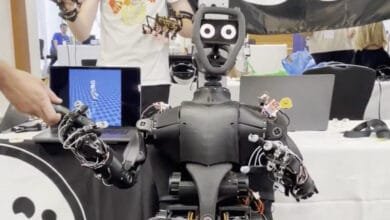Hugging Face’s New Robotics Model Runs Efficiently on a MacBook

▼ Summary
– Hugging Face released SmolVLA, an open AI model for robotics that outperforms larger models in virtual and real-world environments.
– SmolVLA aims to democratize vision-language-action models and accelerate research for generalist robotic agents.
– The model is part of Hugging Face’s broader effort to build a low-cost robotics ecosystem, including acquisitions like Pollen Robotics and tools like LeRobot.
– SmolVLA is lightweight (450M parameters), runs on consumer GPUs or MacBooks, and supports asynchronous inference for faster robot responses.
– Hugging Face faces competition in open robotics from Nvidia, K-Scale Labs, and other firms like Dyna Robotics and Physical Intelligence.
Building advanced robotics projects at home just got more accessible thanks to Hugging Face’s latest innovation. The AI development platform recently unveiled SmolVLA, an open-source robotics model designed to run efficiently on consumer hardware like MacBooks while delivering performance comparable to larger systems.
Trained on community-shared datasets with compatible licenses, SmolVLA represents a significant step toward democratizing robotics research. Hugging Face describes it as a lightweight yet powerful vision-language-action (VLA) model that accelerates progress in developing generalist robotic agents. Unlike bulkier alternatives, this 450-million-parameter model can operate on affordable hardware, including Hugging Face’s own robotics platforms and even a single consumer-grade GPU.
One standout feature is its asynchronous inference stack, which decouples action processing from sensory input analysis. This architecture enables faster responses in dynamic environments—a critical advantage for real-world robotics applications. Early adopters have already tested SmolVLA with third-party robotic arms, demonstrating its potential with minimal fine-tuning.
Hugging Face’s push into accessible robotics extends beyond software. The company has been expanding its ecosystem through initiatives like LeRobot, a repository of robotics models and datasets, and strategic acquisitions such as Pollen Robotics. Their goal? To lower barriers for developers and researchers exploring next-gen robotic solutions.
While Hugging Face leads in open robotics innovation, competition is heating up. Industry giants like Nvidia and startups such as K-Scale Labs are also advancing open-source robotics frameworks. With projects like SmolVLA making high-performance robotics more attainable, the field is poised for rapid evolution—bringing sophisticated automation within reach of hobbyists and professionals alike.
For those eager to experiment, SmolVLA is available for download on Hugging Face’s platform, offering a practical entry point into cutting-edge robotics development. Early tests suggest it could become a foundational tool, much like BERT was for natural language processing—ushering in a new era of accessible, high-performance robotics.
(Source: TechCrunch)





